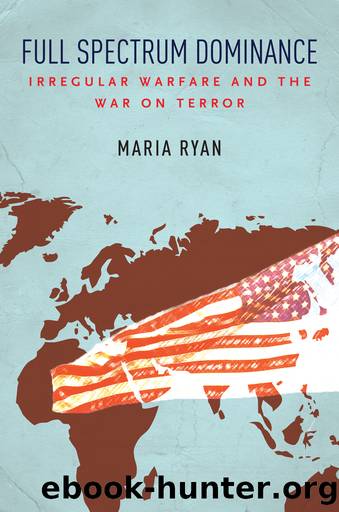Full Spectrum Dominance by Maria Ryan;

Author:Maria Ryan; [Ryan, Maria]
Language: eng
Format: epub
Publisher: Stanford University Press
Published: 2019-08-14T16:00:00+00:00
6
State, USAID, and the Interagency Mobilization
The intellectual and organizational shift toward Irregular Warfare occurring at the Department of Defense was also evident at the US Agency for International Development (USAID) and the State Department. Not only were civilians at these agencies beginning to devote time and resources to dealing with the supposed root causes of terrorism; they were also attempting to do this with the DoD in an interagency fashion that would mobilize the full panoply of US government political, economic, developmental, informational, and security measures. Once again, the intellectual and strategic basis for this was the Bush administration’s emphasis on weak and failing states as the chief cause of terrorism and the belief that countering irregular challenges was an inherently political project that required a whole-of-government approach. From 2004 onward, the State Department and USAID underwent a process of bureaucratic, intellectual, and financial reorganization designed to meet the challenge of weak and failing states. Since these agencies were responsible for the nonmilitary elements of nation building, their new policies entailed an emphasis on development that had not been seen since the heyday of modernization theory in the 1960s, when US policymakers tried to expedite the evolution of capitalism in the developing world as an antidote to the appeal of communism.1 As the head of USAID, Andrew Natsios, told Congress in April 2005, the focus on weak states meant “the whole spectrum of our foreign policy establishment had to be engaged and many of its programs redesigned. . . . Indeed ‘development’ today has received a level of commitment not seen since the Kennedy or Truman administration.”2 The rationale for development in the twenty-first century was overtly securitized. Since weak states were viewed as the cause of one of the most salient security problems of the twenty-first century, development was deemed an appropriate response—and one that civilian foreign service agencies were ideally suited to. This was in keeping with the Pentagon’s directive on stability operations, 3000.05, which acknowledged that many tasks related to stability and reconstruction were best undertaken by civilian experts, though the military would develop the capacity to do this where necessary. However, the civilian capacity for reconstruction and development would ultimately be an integral component of an Irregular Warfare approach. The military transformation agenda, encompassing new ways of thinking about twenty-first-century security threats, was now accompanied by transformational development and transformational diplomacy, both of which sought to address the security implications of weak and failing states in the twenty-first century. Though progress was often slow—mainly because Congress did not support initiatives put forward by the administration—the new initiatives at State and USAID nevertheless constituted a meaningful attempt to mobilize an interagency response to irregular challenges and demonstrated that the focus on security in failed states transcended the Pentagon.
Office of the Coordinator for Reconstruction and Stabilization
Historically the State Department played the lead coordinating role in the US government’s counterterrorism efforts. Its Office of the Coordinator for Counterterrorism was established after the terrorist attacks at the Munich Olympics in 1972 to develop and coordinate counterterrorist policy for the US government.
Download
This site does not store any files on its server. We only index and link to content provided by other sites. Please contact the content providers to delete copyright contents if any and email us, we'll remove relevant links or contents immediately.
The Secret History by Donna Tartt(16605)
The Social Justice Warrior Handbook by Lisa De Pasquale(11485)
Thirteen Reasons Why by Jay Asher(7777)
This Is How You Lose Her by Junot Diaz(5747)
Weapons of Math Destruction by Cathy O'Neil(5027)
Zero to One by Peter Thiel(4815)
The Myth of the Strong Leader by Archie Brown(4783)
Promise Me, Dad by Joe Biden(4439)
Stone's Rules by Roger Stone(4409)
Beartown by Fredrik Backman(4398)
How Democracies Die by Steven Levitsky & Daniel Ziblatt(4391)
The Fire Next Time by James Baldwin(4336)
100 Deadly Skills by Clint Emerson(4069)
A Higher Loyalty: Truth, Lies, and Leadership by James Comey(4024)
Rise and Kill First by Ronen Bergman(4006)
The David Icke Guide to the Global Conspiracy (and how to end it) by David Icke(3874)
The Farm by Tom Rob Smith(3868)
Secrecy World by Jake Bernstein(3773)
The Doomsday Machine by Daniel Ellsberg(3725)
